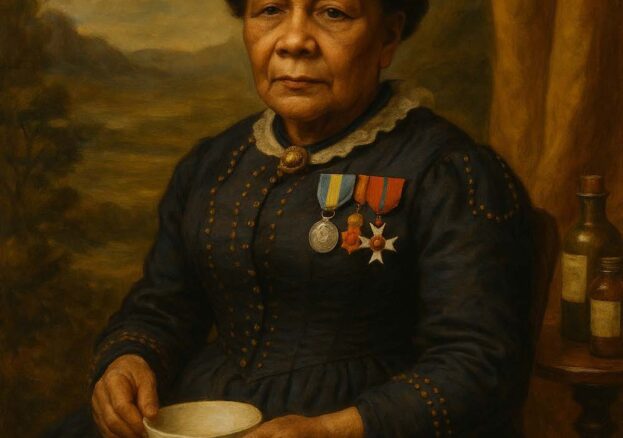
On the windswept plains of Crimea, soldiers told stories of a woman who came to them when pain and fear seemed overwhelming. Dressed in a bright gown and bonnet, she appeared through the haze of gunpowder with bandages, medicines, and words of reassurance. They called her “Mother Seacole.” To men broken by disease and battle, she was not only a nurse but a symbol of home and hope.
Mary Jane Grant was born in Kingston, Jamaica, in 1805. Her father was a Scottish officer in the British Army, her mother a free Jamaican woman of mixed heritage who ran a boarding house for officers. Known locally as “Mother Grant,” she was skilled in traditional Caribbean medicine, blending African herbal knowledge with European practice. From her, Mary learned how to prepare remedies, how to comfort the sick, and how to stay calm in the face of illness and death. In her memoir, Mary remembered these early lessons simply: “It was very natural that I should inherit her tastes; and so, I early became a nurse.”
As a young woman, Mary grew restless in Kingston. She travelled widely through the Caribbean, to Haiti, Cuba, and the Bahamas, learning more about disease and healing in tropical climates. In Panama, she faced cholera head-on. When an outbreak devastated the town of Cruces, she worked tirelessly to care for the sick, often in dangerous and unsanitary conditions. Her courage, quick thinking, and willingness to act when others shrank back earned her a reputation that crossed racial and class barriers. In an age when few women, and fewer still women of colour, were granted authority, Mary carved out her own.
These experiences prepared her for what was to come. In 1853, Britain and its allies entered the Crimean War against Russia. Reports filtered back of appalling conditions: soldiers dying not only from battle wounds but from cholera, dysentery, and frostbite. Mary travelled to London, determined to help. She applied to the War Office and to Florence Nightingale’s team of nurses, but was rejected. She suspected racial prejudice was at the heart of her exclusion, asking bitterly in her memoir: “Did these ladies shrink from accepting my aid because my blood flowed beneath a somewhat duskier skin than theirs?”
Mary refused to give up. With her own money, she booked passage to Crimea and in 1855 established the British Hotel near Balaclava. Part canteen, part storehouse, and part clinic, it offered food, rest, and medical care to officers and soldiers alike. But her greatest impact was not inside its walls. Mary ventured onto the battlefields themselves, carrying supplies and treating the wounded under fire. Soldiers recalled her fearless presence, her skill in dressing wounds, and her ability to lift spirits with her humour and warmth. To them she was not an outsider but a saviour, and the name “Mother Seacole” was spoken with gratitude and affection.
The war ended in 1856. Mary returned to Britain, but her finances were shattered. She had invested heavily in the British Hotel, and peace had left her with worthless stock. Yet the soldiers she had cared for did not forget her. That same year, a grand festival was held at the Royal Surrey Gardens in her honour, attended by thousands, from veterans to royalty. In 1857 she published The Wonderful Adventures of Mrs Seacole in Many Lands, one of the first travel memoirs by a Black woman in Britain. Its pages reveal her voice: witty, direct, proud, and unashamed of her achievements. She wrote not as a victim, but as a woman who had lived boldly across continents and through crises.
Mary lived the rest of her life between Britain and Jamaica. She never became wealthy, but she remained beloved among the veterans who had served in Crimea. In 1881, at the age of 76, she died in London and was buried at Kensal Green. For decades, her grave lay quiet, and her name slipped from public memory, overshadowed by the fame of Florence Nightingale.
Yet history has a way of rediscovering those too long overlooked. In the late 20th century, scholars and campaigners brought Mary’s name back into the national story. In 2004 she was voted the “Greatest Black Briton.” In 2016 a bronze statue was unveiled at St Thomas’ Hospital in London — the first in the United Kingdom to honour a named Black woman. It shows her striding forward, cloak billowing, as if still moving through the smoke of battle to reach the men who needed her most.
Mary Seacole’s life was not easy. She faced racial prejudice, financial hardship, and official indifference. But she answered with courage, skill, and resilience. She was a nurse, a businesswoman, a traveller, and above all, a woman of deep compassion. Her story reminds us that history is not only made in palaces and parliaments, but also in makeshift clinics, cholera huts, and on battlefields where humanity is tested most severely.
For Black History Month, she stands as a symbol of determination in the face of rejection, of compassion in the midst of suffering, and of the unacknowledged contributions of Black women in Britain’s past. Mary Seacole did not ask permission to serve; she simply did what needed to be done. And in doing so, she left behind a legacy that belongs not just to nursing or to military history, but to all of us.
Further Reading & Sources
- Mary Seacole, The Wonderful Adventures of Mrs Seacole in Many Lands (1857)
- Jane Robinson, Mary Seacole: The Charitable Adventuress (2005)
- Helen Rappaport, In Search of Mary Seacole (2022)
- The Mary Seacole Trust
- Statue of Mary Seacole, St Thomas’ Hospital, London (2016)
